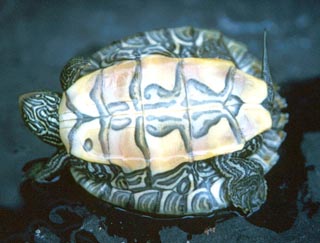Common Map Turtle
Category: Turtle

Facts about Common map turtle. "Scientific name for Common Map turtle is Graptemys geographica". Common Map turtle are also known as northern map turtles. They are aquatic and belong to the family of emydidae. Both male and female Common Map turtle have light markings on the skin which looks like contour lines on a map. The Common Map turtle also have carapace which is olive or grayish brown. The carapace’s lines are shades of yellow or orange surrounded by dark borders. This is where they get their common and scientific name from.
The older Common Map turtles carapace markings fades and can be visible only when the carapace is wet. This is because of the dark pigment. The carapace is broad with a moderate low keel. The plastrons of adults are plain yellow in color. The head, neck and limbs of the Common Map turtle are black, brown or dark olive with yellow or green stripes. Behind the eyes you will notice that they have an oval spot.
The sizes of common map turtles differ according to their sexes. The females are larger than the males. The male Common Map turtle have more distinctive keels, narrow heads, long front claws and thick tails. Their carapace is also more oval than that of the females. Their vent opens up beyond the edge but for the females the vent opens up fully.
The young ones are also a bit different. Their plastron consists of dark lines. The dorsal keel is more pronounced. The hatch-lings have a grayish brown carapace which is around 1 inch (2.54 cm) long. The pattern has light circular markings and the stripes on the head and limbs resemble those of the adults.
Common map turtles mostly inhabit lakes, ponds and rivers. But they like rivers than the ponds and lakes. The Common Map turtle prefer large bodies of water especially the areas that have fallen trees to give them good basking space.
The Common Map turtle absorb their oxygen from the water which is a common characteristic among all common turtles. This oxygen helps them to survive through winter because in this season they mostly stay in water and the ice makes it hard for them to breath. The Common Map turtle stay dormant from November to early April though this entirely depends on the local climatic factors.
Common map turtles breeding start in the spring and fall. Mating takes place in deep waters and nesting lasts from May to July. The females deposit the eggs in well drained places especially on the sandy soils. The eggs are oval and about 1 1/4 inches (3.2 cm) long with a flexible shell. They dig a nest cavity using their hind legs and when the eggs are laid the cavity is filled.
Hatching of the eggs takes around 50-70 days of incubation. In August or September the hatch-lings emerge. The sexes of the young ones entirely depend on the temperatures. If the temperature is at 25 degrees Celsius (77 F) more male Common Map turtle are produced, if it is around 30-35 degrees Celsius (86 - 96 F) more females are produced.
Their feeding program also takes place in water and they are carnivorous. The Common Map turtle mostly feed on mollusks, insects and crayfish. Since the females have wider heads and broad alveolar crushing surfaces in their mouths, they feed on larger prey than the males.

 Back To Category Turtle
Back To Category Turtle